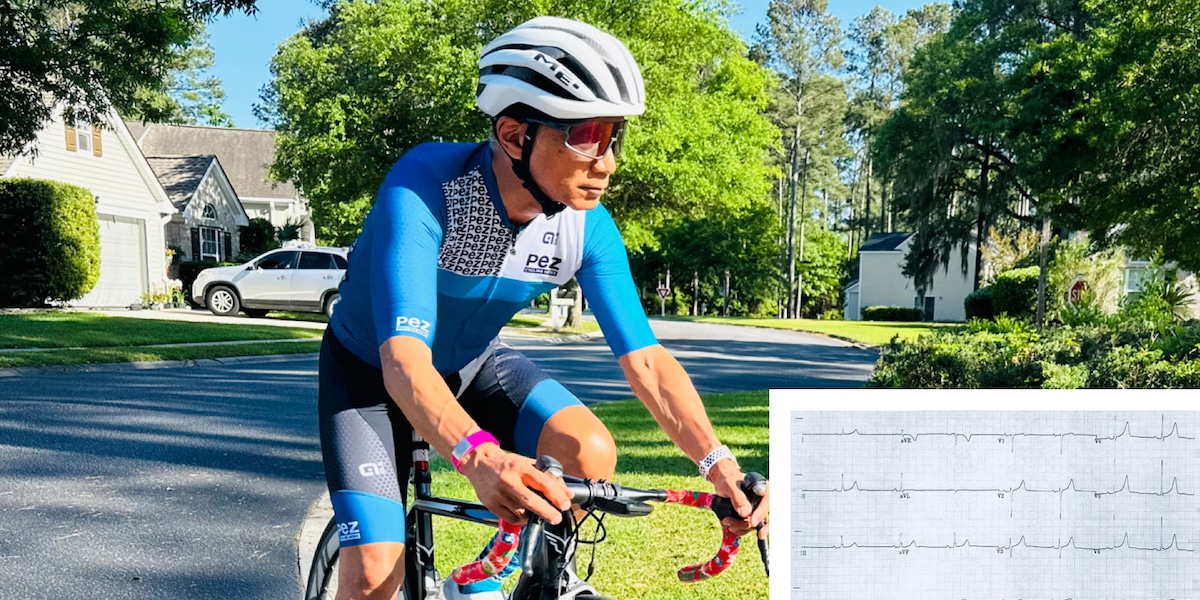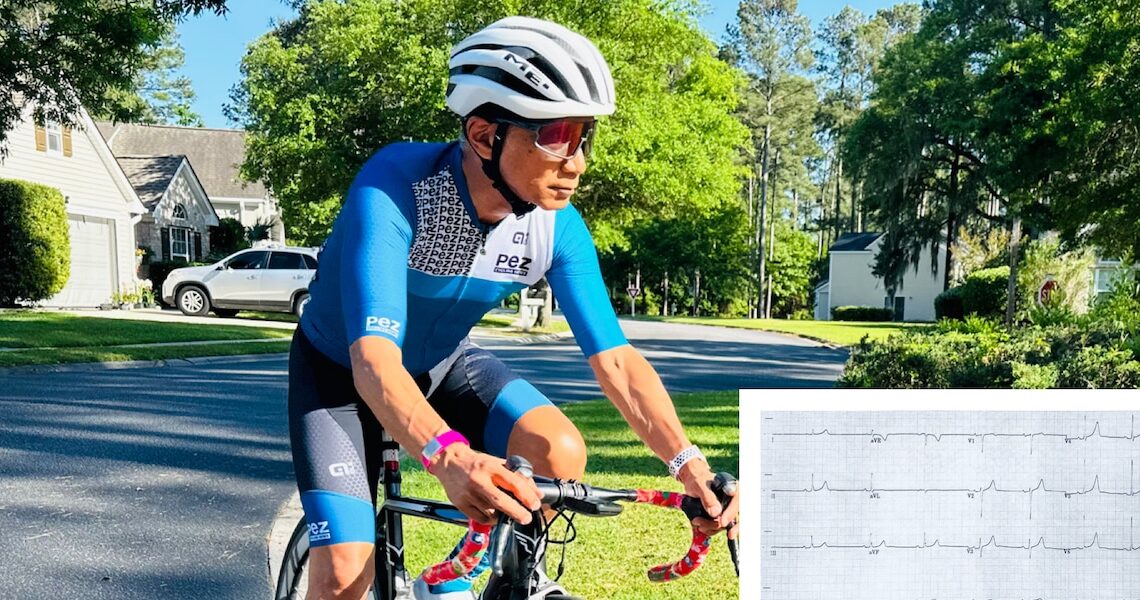
Atrial fibrillation (AFib) is a heart condition that can affect even the fittest individuals, often presenting without obvious symptoms. As a dedicated cyclist in good health, I was surprised by my AFib diagnosis in July 2023. Since then, I’ve navigated the challenges of riding and living with AFib, ultimately undergoing a successful catheter ablation that left me AFib-free. In this update, I reflect on the journey—from the initial diagnosis and treatment with Eliquis to recovery and getting back on the bike—while highlighting the importance of awareness and proactive heart health, especially for active individuals (even more so for older athletes).
DISCLAIMER: I am not a medical professional. If you believe you have AFib or any other heart/medical condition that needs attention, please consult with your personal medical provider.
It’s been a year since I wrote about being diagnosed and riding with AFib (atrial fibrillation). Here’s the original article, but a quick review:
- A friend who is a few years younger than me and still a competitive age-group triathlete had a heart episode while at a hospital (he was there for another not heart-related reason, so both ironic and lucky for him) that required immediate emergency care.
- Even though I’m in good physical condition and was not experiencing anything unusual with my heart (the most common symptom of AFib is palpitations, a fast, fluttering, or pounding heartbeat), I thought if something like that could happen to my friend who is younger and in better shape than me, it would probably be a smart idea to get myself checked out.
- I was diagnosed with AFib in July 2023 .
In the ensuing months, I’ve received several nice notes from PEZ readers wanting to know how I’m doing, so I thought it would be good to provide an update.
At the time I wrote the article, my cardiologist had prescribed Eliquis for my AFib. Eliquis is a blood thinner that helps prevent blood clots, which is the major concern with having AFib. And while using Eliquis I was able to ride like I normally would — meaning 100+ miles a week; most weekday rides solo and easy/moderate (except for my Wednesday Night Hill Ride aka WNHR aka Peña Peña aka Pain Party that is sometimes described as a combination of intervals and weightlifting); harder and longer rides on the weekends (but I’m no longer racing or training for anything so my riding is just riding).
But Eliquis doesn’t “fix” AFib. So while using Eliquis, I still received AFib notifications from my Apple Watch. Not daily, but a couple times a week on average. And I knew that AFib could effect my riding. For example, as I wrote in my original article:
Again, I’m not a medical professional and this is a single anecdotal data point, but …
- My Apple Watch notified me of multiple AFib detections in the early morning hours on a Friday.
- That Saturday when I rode, I went relatively easy but my heart rate was high for the level of effort.
- That Sunday when I rode, I “plateau’ed” in terms of power output, i.e., I just couldn’t go any harder on sections where I would normally be able to, and my heart rate wasn’t elevated for the level of effort.
I wasn’t in AFib during the rides (according to my Apple Watch), but I surmised I was feeling the lingering effects of AFib. FWIW, my cardiologist and another heart specialist both subsequently told me my “diagnosis” was probably right.
At the end of my original article I wrote:
As this goes to press, I am scheduled for a catheter ablation in early March. I’ll be having it done at a hospital with one of the best cardiac electrophysiology programs and staff in the country. And my surgeon will be the chief of complex ablation. So in good hands. Hopefully it all goes well and I will be AFib-free afterwards. I’ll keep y’all posted!
So here’s what’s happened since then …


My last ride on the weekend before catheter ablation — 40 miles with a couple of fallen trees
On March 13, 2024, my good friend, Bob Goulder aka The Real Bobke, picked me up early in the morning at my apartment and drove me to Virginia Hospital Center. After pre-op and waiting my turn in line, I was in the operating room for probably a couple of hours. I spent the afternoon in recovery and Bobke picked me up and drove me back to my apartment around 5 pm. So in-and-out in a day.

Mission accomplished!
I was told to rest for 48 hours and could resume light exercise after that. The next few weeks were easy walks starting at one mile and then two. But after about 3-1/2 weeks, I was back on the bike. My first ride was an easy-ish 20-something miles down in the Lowcountry in early April. I kept my riding at that for the next couple of weeks. But by the end of the month I was up to 40 miles. And pretty much “normal” riding beginning in May and ever since.

My first ride back from catheter ablation
After follow-ups with my cardiologist and electrophysiologist, my heart was deemed healed (after 60 days instead of the usual 90 for catheter ablation) such that I could ride as hard as I wanted and I was declared AFib-free. My EKG was fine (normal sinus rhythm) and I was taken off Eliquis (also taken off an anti-arrhythmia drug that’s a normal precaution after having a catheter ablation).
And I’m happy to report that I haven’t had an AFib notification from my Apple Watch since my catheter ablation. I also fairly regularly take an EKG (ECG) on my Apple Watch and those have all been normal sinus rhythm.
I haven’t ridden as much as in previous years, but since my catheter ablation I’ve logged over 2,000 miles without any issues. One interesting phenomena is that my resting (and sleeping) heart rate isn’t as low as it was pre-catheter ablation. Both my cardiologist and electrophysiologist said not to worry about it and that over time it might come back down to what it was (but if it didn’t, not a cause for concern).

My last AFib notifications before catheter ablation. Note the 140 notifications from when I first started using my Apple Watch to monitor AFib (August 2023)
Otherwise, I’m pretty much back to riding at more or less my previous level. One indication of that is the Sunday group ride I do on Hilton Head Island. It’s a flat and fast (not my forte) training ride that sometimes ramps up to real race pace. For the most part, I can hang in and hang on (sometimes just barely) with the front group — but if they decide to go nuclear and take it up to sustained warp speed, I inevitably have to pull the parachute and ride with the second group, which isn’t that much slower (but perhaps a little bit wiser).

A typical Sunday ride on Hilton Head Island
Thanks again to PEZ readers who wanted to know how I was doing. I appreciate your thoughtfulness and concern. And I’ll reiterate what I previously wrote:
Even though you may be in good/great shape and not experiencing any heart issues/symptoms, my experience would say that it still might be a good idea to get yourself checked.
- Estimates of the prevalence of AFib in the United States ranges from about 2.7 million to 6.1 million. That number is estimated to rise to 12.1 million in 2030.
- One analysis shows a high prevalence of undiagnosed AFib in the United States, i.e., people like me who have AFib but don’t know it because they’re otherwise in good shape, healthy, and not experiencing any symptoms
- Worldwide, the estimated number of individuals with AFib in 2010 was 33.5 million, according to a 2013 study. That’s about 0.5 percent of the world’s population.
- AFib increases the risk of stroke by fivefold and nearly 35 percent of people with AFib will have a stroke.

Especially for those of y’all who are AARP-eligible:
- AFib is the most common arrhythmia in middle-aged athletes. Physical exercise performed in a regular basis has been shown to be beneficial for cardiovascular health. Moderate physical exercise, aside from producing a nice, peaceful and well-being sensation, has been associated with a reduced risk of AFib. However, more strenuous endurance exercise, like experienced marathon runners, seems to increase the risk of AFib in healthy athletes without organic heart disease.
- While the prevalence of AFib is low in young competitive athletes, it increases substantially in the aging athlete, which is possibly associated with an accumulation of lifetime training hours and participation in competitions. A recent meta-analysis revealed a 5-fold increased risk of AFib in middle-aged endurance athletes with a striking male predominance.
- Growing evidence indicates that chronic high-intensity endurance exercise predisposes male, middle-aged athletes to increased risk of AFib.
 Ride on!
Ride on!
Finally, I’m happy to report that I haven’t had to give up espressos or Negronis (and have added the Paper Plane to my cocktail repetoire). Just everything in moderation.
 It wouldn’t be a ride without espresso
It wouldn’t be a ride without espresso
REPEATING THE DISCLAIMER: I am not a medical professional. If you believe you have AFib or any other heart/medical condition that needs attention, please consult with your personal medical provider.
The post UPDATE: Riding with AFib appeared first on PezCycling News.




